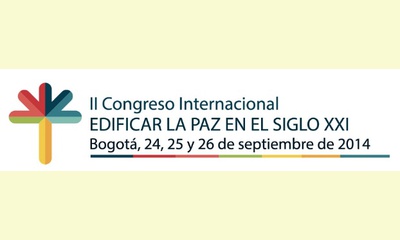|
|
Women, rurality and historical memory among the themes of the Peace Congress [Bogotá, Colombia]
an article by Mónica Parada Llanes, La Republica (abridged)
What do they have in common, Peter Cunningham, expert in
mediation from the Nelson Mandela Metropolitan University; Irina
Bokova, Directrice-Generale of Unesco; and Ivan Pera, director of
the Foundation Charter of Peace addressed to the UN? All are part of
the team of 43 national and international experts who will be at the
Second International Conference "Building Peace
in the XXI Century" to be held later this month at the
University of La Salle. 
click on photo to enlarge
In an interview with Legal Affairs, the Vice Chancellor of the
University, Frank Ramos, spoke about the the event and their
expectations of assistance.
How did this conference come about?
Several things come together to make it possible. The first is that
the University of La Salle has had a new educational proposal in
recent years to create training processes in order to transform
Colombian society . . .
The second is that, the new rector, Carlos Gomez attended two
years ago the first peace congress, an initiative of Letter of Peace
addressed to the UN, . .
And the third concerns the progress of the congress. Since it
coincides with the peace talks, it took on a more significant
relevance. We might say it has been a pleasant coincidence.
Precisely. Considering its coincidence with the peace process,
is there any cooperation from the government or they are going to
participate?
President Santos had the opportunity earlier this year to meet the
Utopia project and has been very interested in the subject and its
experience as a teaching method to replicate. He knows about the
Congress and was interested in coming but he has to go to the UN.
However, we are confident that members of the presidency can
attend. . .
What issues will be central?
The first is the issue of the role of women in these contexts of
violence and peace . . .
The second major issue is the new rurality in the context of peace.
Colombia is an agrarian country. We have considered ourselves
urban, but the vast rural population has been invisible. The issues
of conflict have taken place primarily in the rural areas.
A third and fourth issue has to do with creating a culture of peace.
Even if we eventually sign a peace accord with the guerrillas that's
just the first step, the other is to create a collective consciousness
and a culture of non-violence where the problems are not resolved
at the point of shooting and machete but dialog. That cannot be
accomplished overnight and it is most important.
And a fifth theme is historical memory, and post-conflict
reconciliation and that means how to think about history, how to
look back, remember and not strengthen the themes of revenge but
think about how to turn the page so as to benefit generations to
come.
In the end we hope to develop a very simple document with all
these issues in online version that serves as a road map and guide
for people to know what you can do from home or work, for peace.
. .
(Click here for a Spanish version of this article)
|








|
DISCUSSION
Question(s) related to this article:
What is happening in Colombia, Is peace possible?
* * * * *
LATEST READER COMMENT:
The force of non-violence constrains the force of arms!
Colombia - the force of peaceful resistance -
At the beginning of July, the rebels of the armed revolutionary forces of Colombia (FARC) kidnapped a 51 year old Swiss, and his Colombian assistant who worked in the Indian communities of Cauca province where they were setting up development projects by building schools and community production enterprises.
The news of the kidnapping was spread through all the villages and 2000 Indians set out to pursue the 400 guerillas. They reached them at an elevation of over 4000 meters (12,000 feet), encircled them, and without any weapon, constrained them to release the 2 hostages! (After 2 days, the hostages were released).
This release, obtained through "peaceful resistance" has raised a national debate: the possibility of resisting violence without needing to use weapons has demonstrated the effectiveness of human solidarity movements.
"I will return, and I will then be millions" prophesied the Aymara Indian leader Tapak Katari, in 1781, at the time of his execution by the Spanish conquistadors.
100 million in 1492, the Indians were no more than 4,5 million one century and half later. Currently there are 44 million Indians populating Latin America.
In spite of their great diversity, the Indian movements take on more and more importance. In Ecuador, Guatemala, Bolivia, Peru, Mexico or Colombie they are opposed to the neoliberal system that governs the Americas, while protesting against the imposition of the American economic market. . ...more.

|
|









